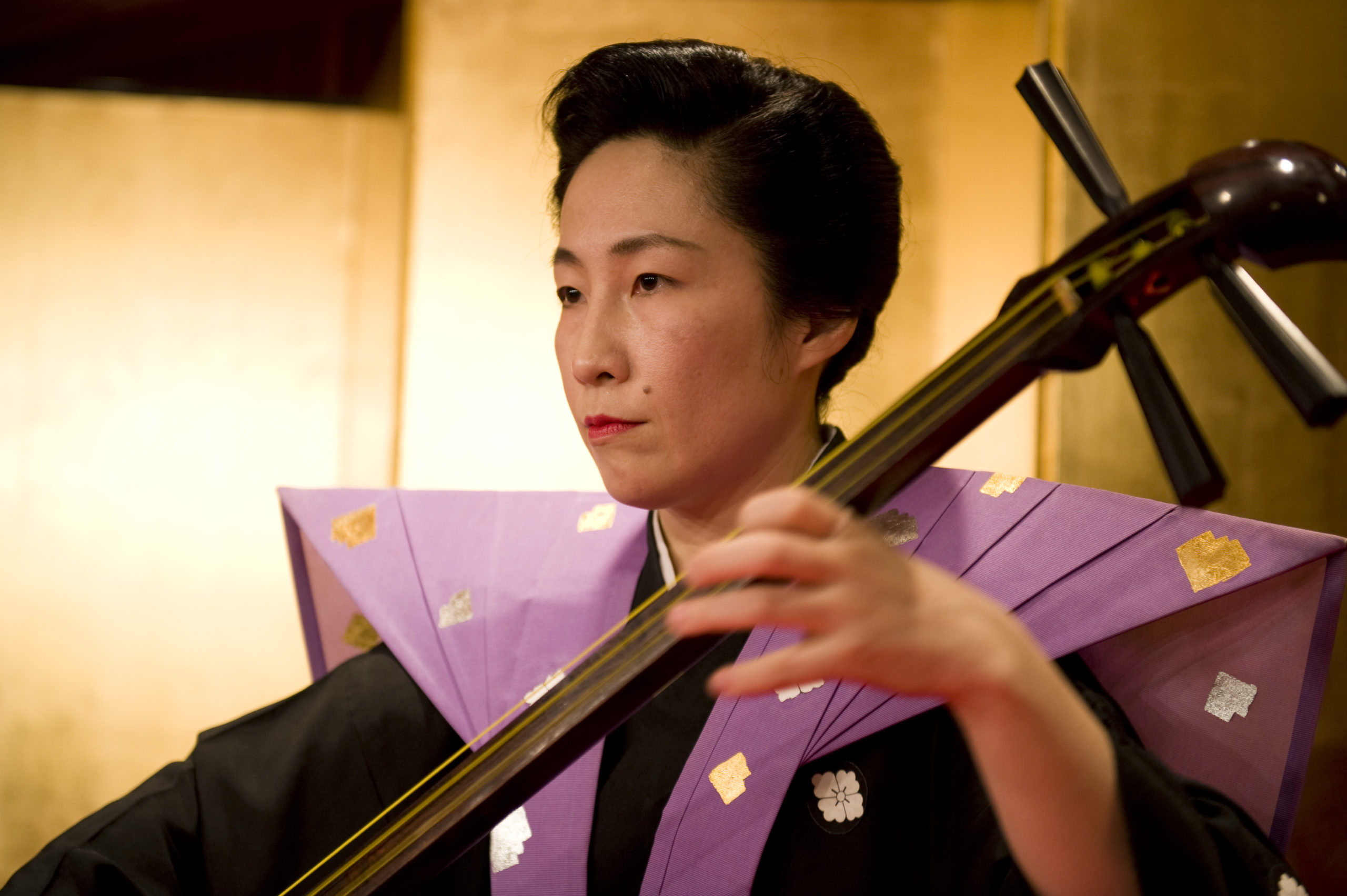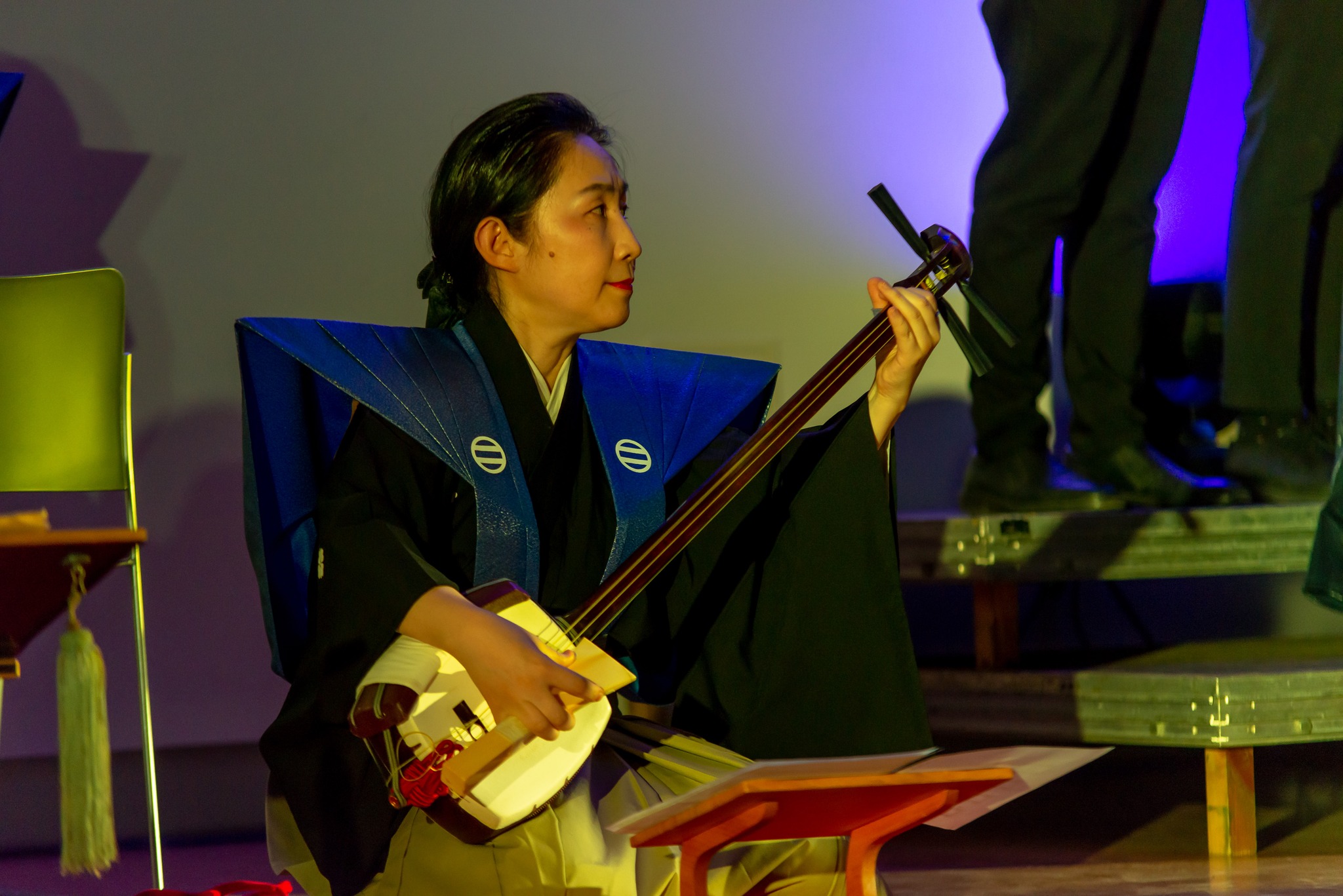I am a syamisen player of Gidayu-bushi. Syamisen is one of Japanese traditional instruments, a kind of guitar. Gidayu-bushi is the musical narrative of the puppet theatre established by Takemoto Gidayu in the late 17C in Japan.
Joryu-gidayu is a female reciter of Gidayu-bushi. Only men can perform for a puppet playing, but the women cannot do it, so women have continued stage activity only by the musical performance without puppet playing for a long time. Gidayu -bushi is so dramatic music that its expression is full of emotion and filled with energy. Nowadays, performance by joryu-gidayu can be enjoyed in various venues in addition to the concerts held regularly. Its fans and supporters have gradually expanded.
Gidayu-bushi is narrative music. Vocal music and musical instruments are division of labor, so usually played by two people.

Sansuzu Tsuruzawa
- Contact person :
- Sansuzu Tsuruzawa
- Position :
- gidayu syamisen player
Last update : 13 Aug. 2022
Works

The Concert of Jiutamai and Gidayu-bushi in Kaunas 2022 LT - Kaunas 2022
Concert program example
1. Sanbasō
Japanese traditional work
Sanbasō is a prestigious song that is sung when congratulations, especially during the New Year. It is called, five grain abundance, and dances in the hope that grains such as rice and wheat will grow abundantly. Grains are important to protect human lives. It is a sacred dance to deliver that wish to God and pray for everyone to be healthy and safe. The choreography of taking prayer steps on the ground where grains grow is impressive.
2. Tomoe
lyrics by Yoshisuke Chino, music composed by Sansuzu Tsuruzawa (2018)
Tomoe Gozen was a late 12th century female samurai warrior, known for her bravery. Her family had strong affiliations with Kiso no Yoshinaka, so Tomoe and Yoshinaka were childhood friends. Although there was a difference between woman and man, they always fought together when they grew up.
Tomoe is best known for her loyalty and courage at the Battle of Awazu in 1184, at which Yoshinaka was killed. This is a work that followed her life.
The details of the actual Tomoe have not been clarified. However, in this work, after the death of her Yoshinaka, she is quietly living her life while praying for the happiness of the soul of Yoshinaka.
There are 3 parts in TOMOE. 1. In childhood friends, 2. Death of Yoshinaka 3. Reminiscing of Yoshinaka.
3. A performance about the Queen of Snakes, Egle
Lyrics and music composed by Sansuzu Tsuruzawa (2022)
In this performance, the role of the priest is expressed in the voice of the performer, and Egle is played by the dancer.
Summary
A play about the Queen of Snakes
One clergyman traveling in the spring afternoon, named Seikai, walks ashore. There, he finds a beautiful pine tree. For a while the clergyman rests under a tree. At first, the sound of pine leaves sounds pleasant. But suddenly the sound becomes lonely.
A woman appears.
“Do you know the legend of this coast? Long ago, one woman married a snake to the king on the seabed. When she returned to her homeland with her children, her family killed her husband. Then she could not return to her beloved husband out of grief. She becomes a tree, and her children also turn into trees. The pines growing here are her and her children. There will be a full moon today.
- Come at night - I will tell you this legend.-
Night is coming. A woman appears and approaches the clergyman. She is said to be the spirit of the Queen of Snakes.
--I married the king of snakes and we lived on the seabed for a long time. I missed the land of my homeland. So we went back to earth with our children for a short time. Then my brothers who disliked my marriage killed my husband. We had nowhere to go back. Without a husband, we couldn’t find a way home, and it was hard for my kids to live on earth among the people. I was sad and angry. I cursed myself and my child. Now we are trees. It is part of us that we have to live here forever, between the sea and the land. -
As a woman speaks, the sound of the waves gets louder.
Depending on the soul of the woman, the clergyman takes the bead and sings the sutra with all his heart. Namu-ami-dabutsu. Suddenly, the woman disappears. The sound of pine needles falls silent and harmonizes with the soothing sound of the waves. And in the water the full moon is beautifully reflected.
Santrauka
Spektaklis apie žalčių karalienę
Viena pavasario popietę keliaujantis dvasininkas, vardu Seikai, eina pakrante. Ten, jis randa gražią pušį. Kurį laiką dvasininkas ilsisi po medžiu. Pradžioje pušų lapų garsas skamba maloniai. Bet staiga garsas tampa vienišas.
Pasirodo moteris.
„Ar žinote šios pakrantės legendą? Seniai, viena moteris ištekėjo už žalčių karaliaus jūros dugne. Kai ji grįžo į tėvynę su savo vaikais, jos šeima nužudė vyrą. Tada ji negalėjo grįžti pas mylimiausią vyrą iš sielvarto. Ji tampa medžiu, ir jos vaikai taip pat virsta medžiais. Čia augančios pušys – tai ir yra ji ir jos vaikai. Šiandien bus pilnatis. Ateikite naktį – papasakosiu šią legendą.“
Ateina naktis. Pasirodo moteris ir prieina prie dvasininko. Ji sako, esanti žalčių karalienės dvasia. „Aš ištekėjau už žalčių karaliaus ir ilgą laiką gyvenome jūros dugne. Pasiilgau savo tėvynės žemėje. Todėl trumpam grįžome į žemę su savo vaikais. Tada mano broliai, kuriems nepatiko mano santuoka nužudė mano vyrą. Neturėjome kur grįžti. Be vyro negalėjome surasti kelio į namus, ir mano vaikams buvo sudėtinga gyventi žemėje tarp žmonių. Man buvo liūdna ir pikta. Prakeikiau save ir savo vaikaus. Dabar mes esame medžiai. Tai mūsų dalia, kad turime gyventi amžinai čia, tarp jūros ir žemės.“
Moteriai kalbant, bangų garsas stiprėja.
Atsižvelgdama į moters sielą, dvasininkas paima karoliuką ir iš visos širdies gieda sūtrą. Namu-ami-dabutsu. Staiga, moteris dingsta. Pušių spyglių garsas nutyla ir harmonizuojasi su raminančiu bangų garsu. O vandenyje pilnatis gražiai atsispindi.
All works are choreographed by Tokijo Hanasaki, and the flute melody of the work 2,3 is arraged by Hyakushichi Fukuhara.
The Lithuanian translation of the synopsis of the work 3 is Aya Kimura
details ↓
https://kaunas2022.eu/wa/
https://www.facebook.com/JapanDaysWA